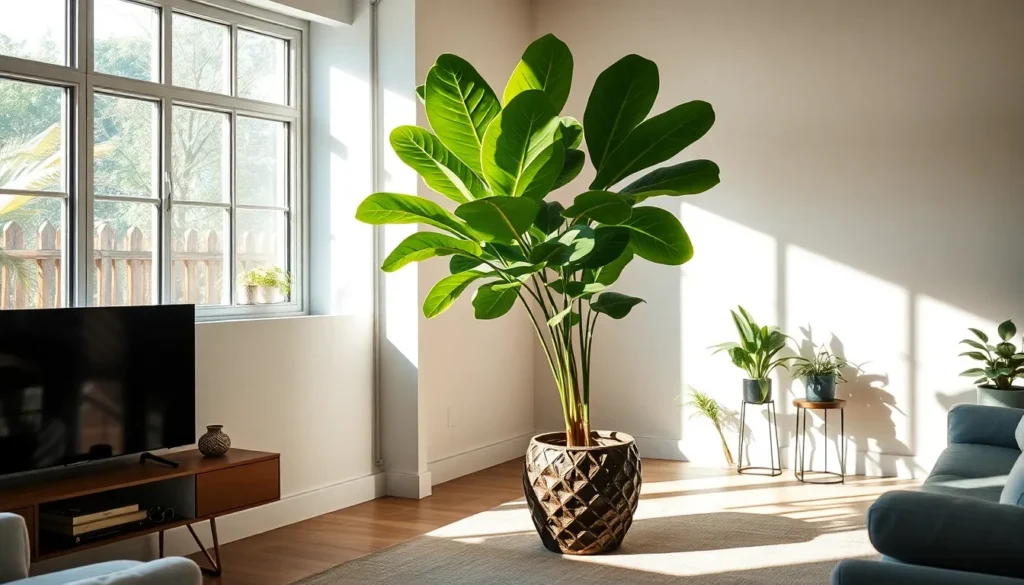We’ve all dreamed of transforming our homes into lush green sanctuaries that rival the most stunning botanical gardens. Large indoor house plants offer the perfect solution for creating dramatic focal points while purifying our air and boosting our mood. These magnificent specimens don’t just fill empty corners – they transform entire rooms into vibrant living spaces.
The beauty of large indoor plants lies in their ability to make bold statements without overwhelming our decor. From towering fiddle leaf figs to sprawling monstera deliciosas, these green giants bring life and energy to any room they grace. We’ll discover how these impressive plants can turn our homes into Instagram-worthy spaces while providing incredible health benefits.
Whether we’re dealing with low-light apartments or sun-drenched living rooms, there’s a perfect large house plant waiting to become our next green companion. Let’s discover the area of statement plants that’ll revolutionize our indoor gardening game.
Choose Low-Light Large House Plants Indoor for Darker Spaces
Not every corner of our home receives abundant sunlight, but that doesn’t mean we can’t enjoy stunning large house plants indoor. These shade tolerant giants thrive in dimmer conditions while still making bold statements.
Fiddle Leaf Fig for Statement Corners
Fiddle leaf figs adapt surprisingly well to lower light conditions even though their reputation for being finicky. We’ve found these sculptural beauties can flourish in corners that receive just 4-6 hours of indirect light daily. Their broad, violin shaped leaves create dramatic silhouettes even in shadowy spaces.
Position your fiddle leaf fig near north facing windows for consistent, gentle illumination throughout the day. These plants reach 6-10 feet indoors and develop striking architectural forms that command attention. Water them only when the top 2 inches of soil feel dry to prevent root rot in low light conditions.
Rotate the plant weekly to ensure even growth since fiddle leaf figs naturally lean toward available light sources. We recommend wiping the large leaves monthly with a damp cloth to maximize their ability to photosynthesize in darker environments.
Rubber Plant for Easy Maintenance
Rubber plants excel in low light situations while requiring minimal care from busy plant parents. These glossy leaved giants tolerate shade better than most large house plants indoor and can survive on as little as 2-3 hours of indirect sunlight daily. Their burgundy tinged foliage adds rich color to dim rooms.
Water rubber plants every 7-10 days during growing season and reduce frequency in winter months. We’ve observed these resilient plants bouncing back quickly from neglect, making them perfect for darker offices or bedrooms. They grow 6-8 feet tall indoors and develop thick, sturdy trunks over time.
Prune rubber plants in spring to maintain desired height and encourage bushier growth patterns. Their natural air purifying qualities work especially well in low light spaces where we spend extended periods.
Monstera Deliciosa for Tropical Appeal
Monstera deliciosas naturally grow under forest canopies in their native habitat, making them ideal large house plants indoor for shadowy spaces. We love how their fenestrated leaves develop even more dramatic splits and holes when grown in lower light conditions. These climbing plants reach 8-10 feet indoors with proper support.
Provide a moss pole or trellis for your monstera to climb, as this encourages larger leaf development even in dim environments. Water when the top inch of soil dries out, typically every 5-7 days depending on humidity levels. Their heart shaped juvenile leaves gradually develop characteristic holes as the plant matures.
Mist the aerial roots weekly to boost humidity around your monstera, especially important in low light conditions where air circulation may be limited. We’ve noticed these plants produce more vibrant green coloration when grown away from harsh direct sunlight.
Select Bright-Light Large House Plants Indoor for Sunny Areas
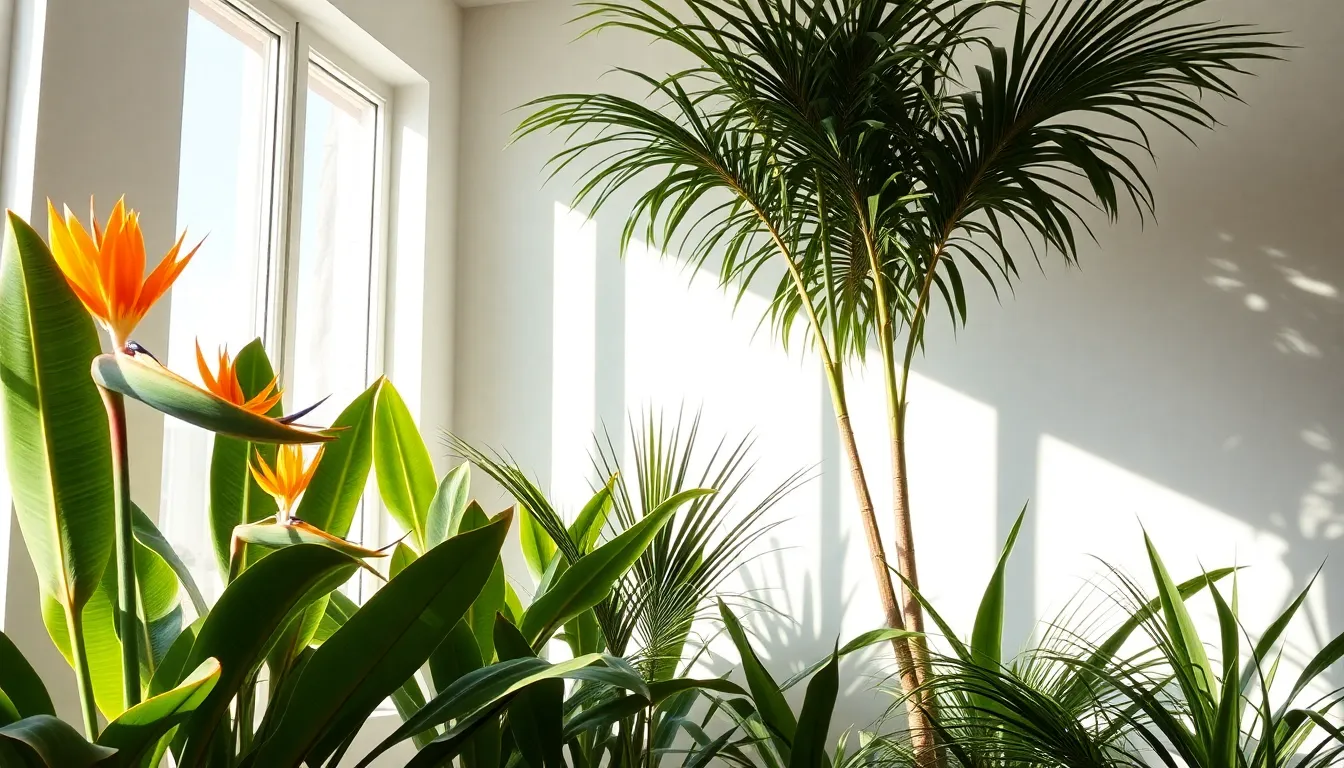
After exploring low-light options, we’re shifting our focus to plants that absolutely thrive in bright, sunny conditions. These sun-loving specimens transform bright corners and south-facing windows into stunning botanical displays.
Bird of Paradise for Dramatic Height
Bird of Paradise plants deliver unmatched vertical drama with their towering 5 to 6-foot indoor height and striking architectural presence. We love how these tropical beauties create instant focal points in large, bright rooms with their distinctive birdlike flowers and broad paddle-shaped leaves.
Position your Bird of Paradise near south or east-facing windows where it’ll receive several hours of direct morning sunlight. These plants absolutely crave bright, direct light to reach their full potential and maintain their vibrant foliage.
Water regularly during growing season while ensuring excellent drainage to prevent root rot. We recommend checking soil moisture weekly and maintaining consistent hydration without waterlogging the roots.
Dracaena for Architectural Interest
Dracaena varieties bring sophisticated sculptural elements to bright indoor spaces with their tall, slender trunks and spiky foliage arrangements. We particularly appreciate how Dragon Trees (Dracaena marginata) create elegant vertical accents that complement modern interior design.
These plants perform exceptionally well in bright, indirect light while tolerating various lighting conditions throughout your home. Position them near bright windows with filtered light for optimal growth and leaf coloration.
Care requirements remain refreshingly simple with watering needed only when topsoil feels dry to the touch. We suggest occasional fertilization during growing months to support healthy development and maintain their striking appearance.
Yucca Plant for Desert Vibes
Yucca plants introduce bold desert aesthetics with their tough, sword-shaped leaves and impressive tree-like stature that often reaches multiple feet indoors. We’re drawn to their sculptural presence that requires minimal maintenance while delivering maximum visual impact.
Bright light to full sun exposure suits these desert natives perfectly, making south or west-facing windows their ideal locations. These plants actually demand intense light conditions to maintain their characteristic robust growth patterns.
Watering should remain sparse and infrequent, allowing soil to completely dry between sessions to mimic their natural arid habitat. We recommend treating them like succulents with minimal water requirements that make them perfect for busy plant parents seeking low-maintenance statement pieces.
Position Large House Plants Indoor for Optimal Growth
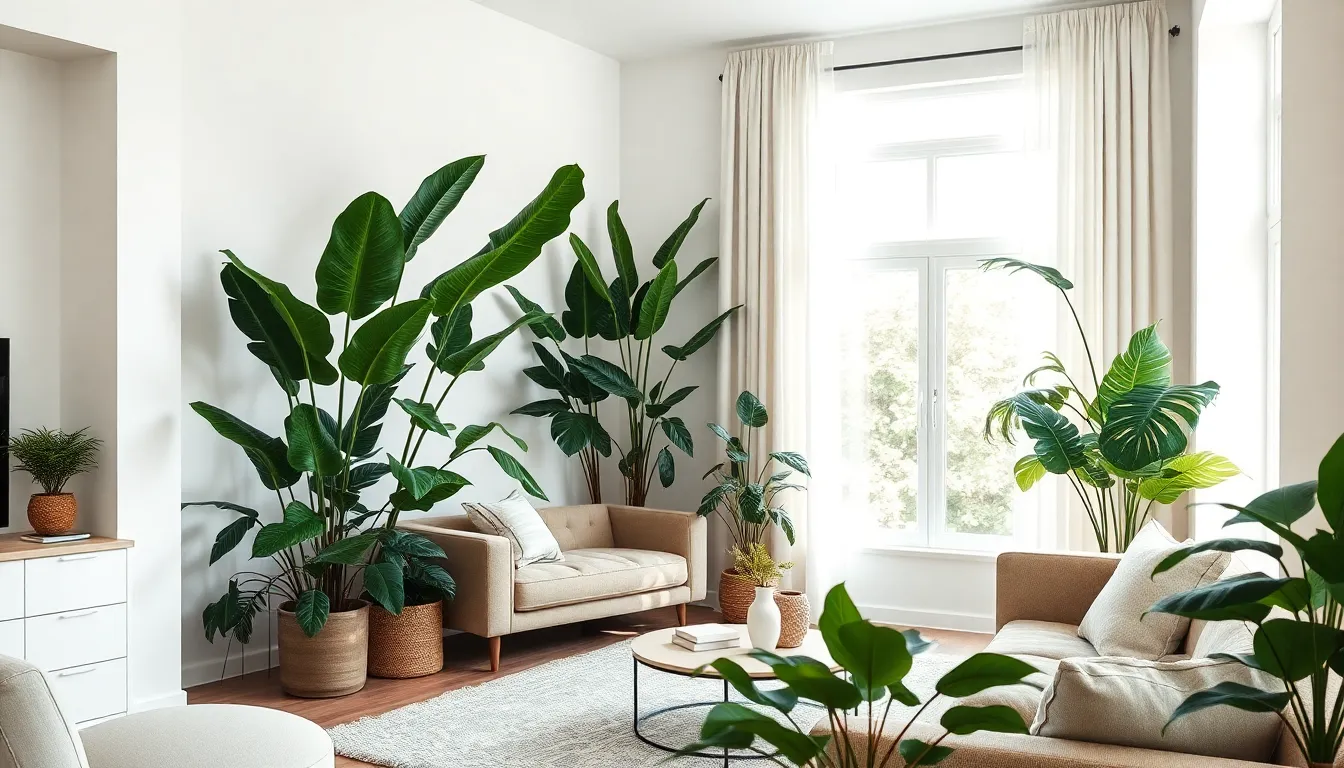
Strategic placement of your stunning large indoor plants determines their success and visual impact. We’ll explore three key positioning strategies that maximize both plant health and aesthetic appeal.
Corner Placement for Maximum Impact
Corners naturally frame large house plants and transform them into striking focal points that anchor your room’s design. These spaces provide an ideal backdrop for tall specimens like fiddle leaf figs or bird of paradise plants without overwhelming your furniture arrangements.
Floor space maximization occurs when we position large plants in corners rather than in the center of rooms. Your living room benefits from this strategic placement as it creates dramatic visual interest while maintaining clear pathways for movement.
Tall and narrow containers work exceptionally well in corner spaces, allowing your plants to reach their full height potential. We recommend choosing corners that receive adequate light while providing enough clearance for plant growth and maintenance access.
Near Windows for Natural Light
Window proximity provides the bright, indirect sunlight that most large indoor plants crave for optimal photosynthesis. South or east facing windows deliver filtered light that promotes healthy growth without the harsh rays that can scorch delicate leaves.
Natural light requirements vary by species, but positioning plants within 3 to 6 feet of windows typically meets their needs effectively. Your rubber plants and monstera deliciosas thrive in these locations where they receive consistent illumination throughout the day.
Indoor and outdoor environments connect beautifully when we place large plants near windows, creating a seamless transition that enhances your home’s natural ambiance. Floor placement near windows or on sturdy windowsills accommodates various plant sizes while ensuring adequate light exposure.
Away from Heat Sources and Drafts
Heat sources like radiators, heating vents, and air conditioners should remain at least 6 to 8 inches away from your large house plants to prevent soil drying and leaf damage. Temperature extremes stress plants and can impede their growth or cause permanent harm to their foliage.
Drafty windows and doors create cold air currents that shock plant systems and disrupt their natural growth patterns. We position plants in stable temperature zones where they won’t experience sudden environmental changes that could compromise their health.
Airflow circulation improves around plants when we maintain proper clearance from heating and cooling sources, reducing the risk of mold development and pest infestations. Your dracaenas and yucca plants particularly benefit from consistent temperatures and gentle air movement rather than direct exposure to artificial climate control systems.
Maintain Large House Plants Indoor with Proper Watering
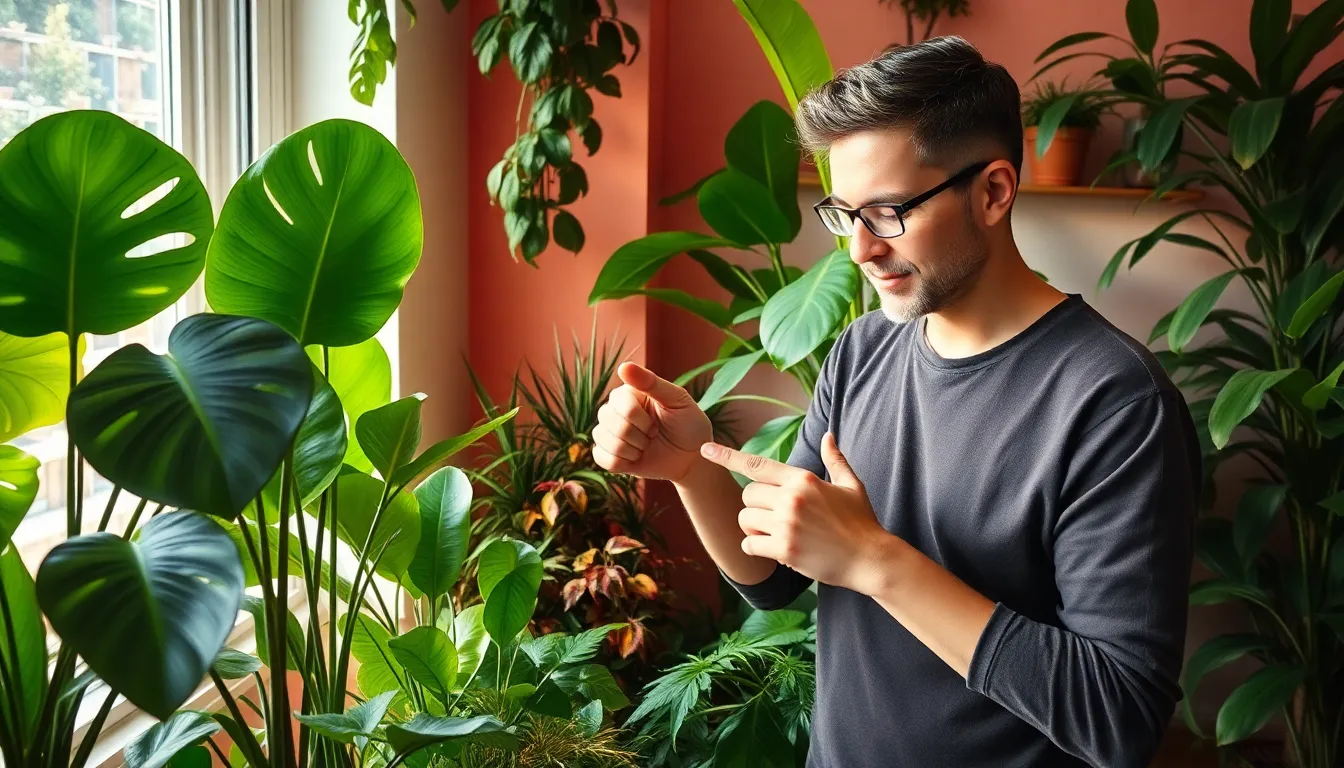
Proper watering serves as the foundation for keeping our large indoor plants thriving in their designated spaces. We’ve found that understanding watering fundamentals prevents the most common plant care mistakes that lead to root rot or dehydration.
Weekly Watering Schedule Guidelines
Large indoor houseplants typically require watering every 1 to 4 weeks depending on their species and environmental conditions. We recommend checking the top 2 inches of soil to determine when watering becomes necessary rather than following rigid schedules. Plants like fiddle leaf figs and rubber plants often need water when their soil feels completely dry at the 2-inch depth.
Summer months increase watering frequency for most large house plants indoor environments due to higher temperatures and increased growth activity. Winter seasons reduce water requirements significantly as plant metabolism slows down during shorter daylight periods. Species variation plays a crucial role since drought-tolerant plants like yucca need less frequent watering compared to moisture-loving varieties.
Soil Moisture Testing Techniques
Finger testing provides the most reliable method for checking soil moisture in large plant containers. We insert our finger 2-3 inches deep into the soil to assess dryness before adding water to prevent overwatering issues. This technique works effectively for most large house plants indoor care routines.
Moisture meters offer precise readings when finger testing feels uncertain or impractical for deeper containers. Digital devices eliminate guesswork by providing numerical moisture levels that help us make informed watering decisions. Visual inspection supplements these methods by checking for soil pulling away from pot edges, which indicates severe dryness.
| Moisture Testing Method | Accuracy Level | Best Use Case |
|---|---|---|
| Finger Test (2-3 inches) | High | Daily monitoring |
| Moisture Meter | Very High | Precise measurements |
| Visual Inspection | Medium | Quick assessment |
Seasonal Watering Adjustments
Spring through early fall represents the growing season when our large house plants indoor collections require more frequent watering. We increase watering frequency during these months because plants consume more water for active growth and leaf development. Temperature, humidity, and extended daylight hours contribute to higher water consumption rates.
Fall and winter months demand reduced watering schedules as plant metabolism naturally slows down in response to cooler temperatures and decreased light exposure. We typically water our large plants 50% less frequently during dormant seasons to prevent waterlogged soil conditions. Environmental factors like heating systems and lower humidity levels still require monitoring to avoid complete soil dehydration.
Room temperature water works best for all seasonal watering routines, preventing shock to root systems that cold or hot water might cause. We water during daytime hours to allow proper absorption and evaporation of excess moisture before cooler evening temperatures arrive.
Fertilize Large House Plants Indoor for Healthy Development
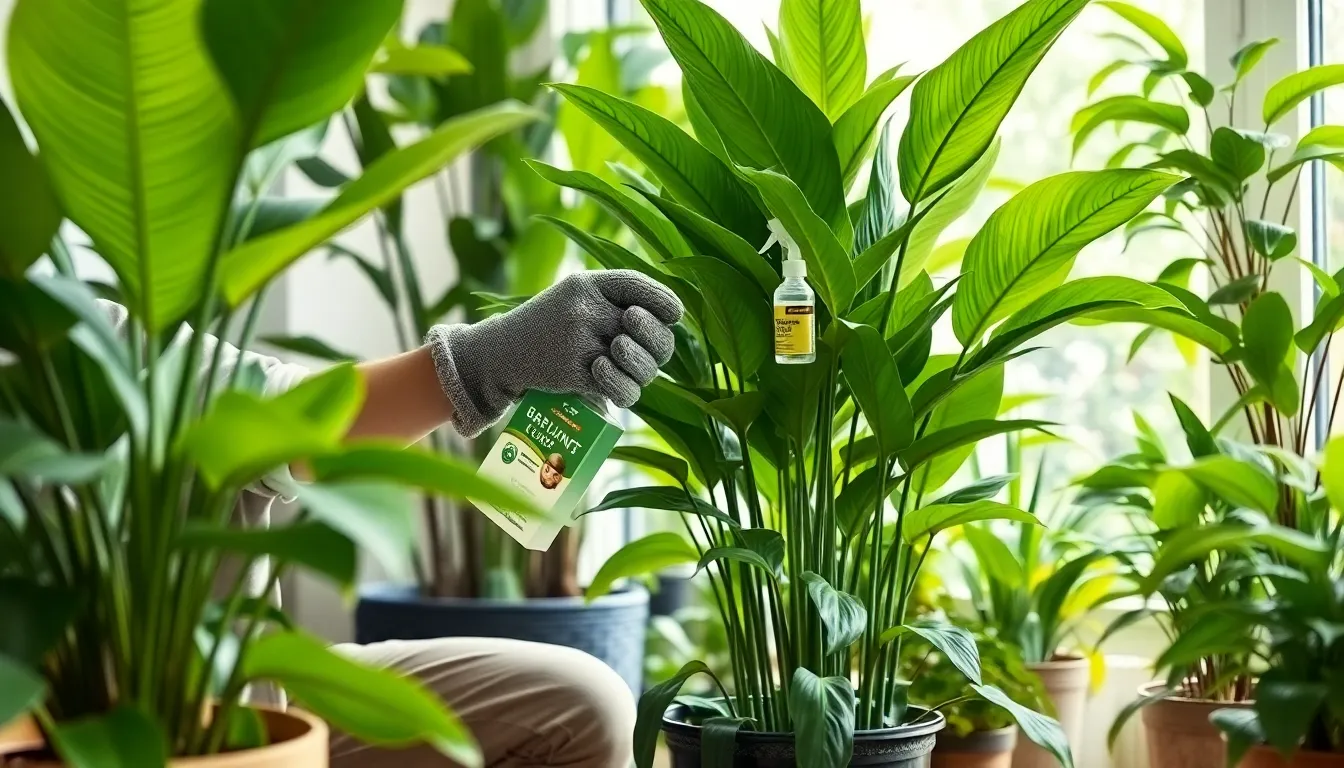
After mastering watering techniques, we need to focus on proper nutrition to keep our large indoor plants thriving year round. Strategic fertilizing ensures robust growth and maintains the dramatic presence these statement plants bring to our homes.
Monthly Feeding During Growing Season
Monthly applications work best for most large houseplants during their active growing periods from spring through fall. We should start feeding our plants about 8 weeks before the last expected frost to prepare them for vigorous growth ahead.
Early spring fertilizing requires diluting answers to half strength as plants emerge from dormancy. Summer months call for full strength applications when growth peaks and nutrient demands increase significantly.
Liquid fertilizers need more frequent attention with biweekly to monthly feeding schedules. Granular and slow release options provide longer lasting nutrition, often sustaining plants for 3 to 4 months between applications.
Timing matters more than we might think since plants actively absorb nutrients during warm weather growing cycles. Winter months require reduced feeding or complete suspension as most large houseplants enter dormant phases.
Organic vs. Synthetic Fertilizer Options
Organic fertilizers introduce beneficial organisms while providing natural nutrition that supports overall soil health. These options include compost, worm castings, fish emulsion, and bone meal that slowly release nutrients over time.
Synthetic fertilizers contain precise amounts of macro and micronutrients, making accurate dosing easier for beginners managing large plants. Chemical formulations typically provide immediate nutrient availability compared to organic alternatives.
Balanced synthetic fertilizers with 10-10-10 N-P-K ratios work effectively for most indoor species. Fast growing varieties like Alocasia may benefit from higher nitrogen formulations such as 20-20-10 during peak growing seasons.
Preference and familiarity should guide our choice between organic and synthetic options. Both approaches can produce healthy results when applied consistently and appropriately for individual plant needs.
Signs of Over-Fertilization to Avoid
Leaf burn or scorch appears as the most common indicator of excessive fertilizing in large houseplants. Brown leaf tips, yellowing margins, and crispy texture signal that we’ve applied too much nutrition too quickly.
Weak, spindly growth paradoxically occurs when plants receive excess nutrients rather than strengthening as expected. Salt buildup creates white crusty deposits on soil surfaces and pot rims that interfere with water absorption.
Under-fertilizing slightly proves safer than over-feeding our valuable large plants. Diluting answers below recommended strength allows gradual adjustment upward if deficiency symptoms appear later.
| Over-Fertilization Warning Signs | What to Look For |
|---|---|
| Leaf burn | Brown tips and crispy edges |
| Salt buildup | White crusty deposits on soil |
| Weak growth | Spindly stems even though feeding |
| Root damage | Black, mushy root systems |
Monitoring plants closely after each feeding session helps us catch problems early before permanent damage occurs. Gradual increases in fertilizer strength work better than sudden concentration jumps that shock plant systems.
Repot Large House Plants Indoor When Root-Bound
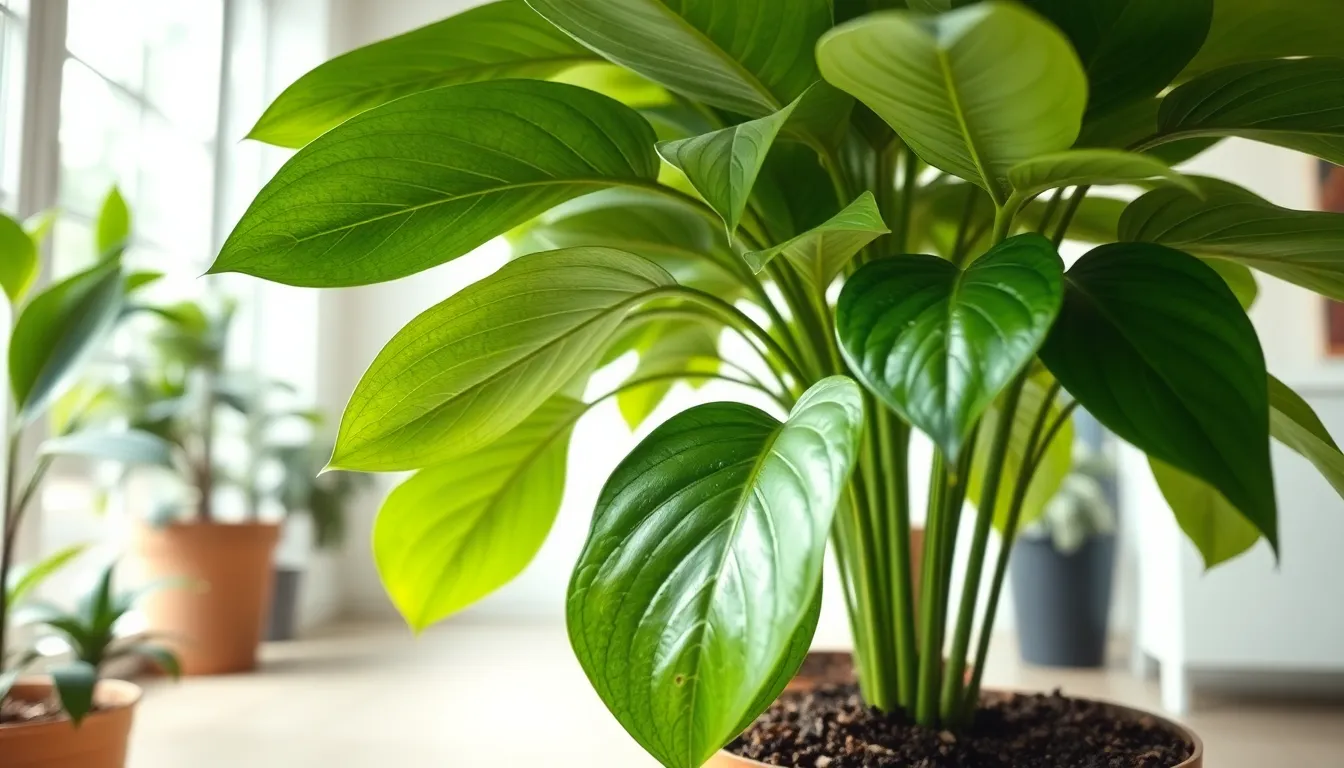
We’ve covered feeding your large indoor plants, but knowing when to repot them is equally crucial for their continued health and growth.
Identifying When Repotting is Needed
Signs that your large house plant needs repotting become quite obvious once you know what to look for. Roots appearing on the surface or growing through drainage holes indicate your plant has outgrown its current container. Water draining too quickly through the potting soil suggests the root system has filled most of the available space. Stunted growth or yellowing leaves even though proper care often signals root restriction is limiting nutrient uptake.
Soil drying out very quickly after watering typically means roots have displaced much of the growing medium. We recommend checking these symptoms during your regular plant maintenance routine. Plants showing multiple signs simultaneously require immediate repotting attention.
Choosing the Right Pot Size
Selecting the right pot size prevents common repotting mistakes that can harm your large indoor plants. Choose a container that’s 1-2 inches wider in diameter than the current pot to provide adequate room for root expansion. Pots that are too large create water retention issues that can lead to root rot and other moisture related problems.
Drainage holes in the new container are essential to prevent waterlogging and maintain proper soil aeration. We’ve found that a modest size increase reduces transplant shock while giving roots space to grow. Very small increases in pot size lead to quick re-rooting and minimize stress on your plant during the transition period.
Best Soil Mixes for Large Plants
Well draining potting mixes that retain moisture without becoming waterlogged work best for large indoor plants. Quality soil components support optimal root health and sustained growth in container environments.
| Soil Component | Purpose | Benefits |
|---|---|---|
| Peat moss or coconut coir | Moisture retention | Maintains consistent hydration levels |
| Perlite or pumice | Aeration and drainage | Prevents compaction and root rot |
| Compost or worm castings | Nutrient richness | Provides slow release organic nutrition |
Using high quality indoor potting soil specifically formulated for large plants or trees ensures your repotting efforts succeed. We recommend avoiding garden soil or generic potting mixes that may not drain properly in containers. Species exact requirements may call for adjusting the basic mix with additional components like bark chips for orchids or extra perlite for succulents.
Prune Large House Plants Indoor for Shape and Health
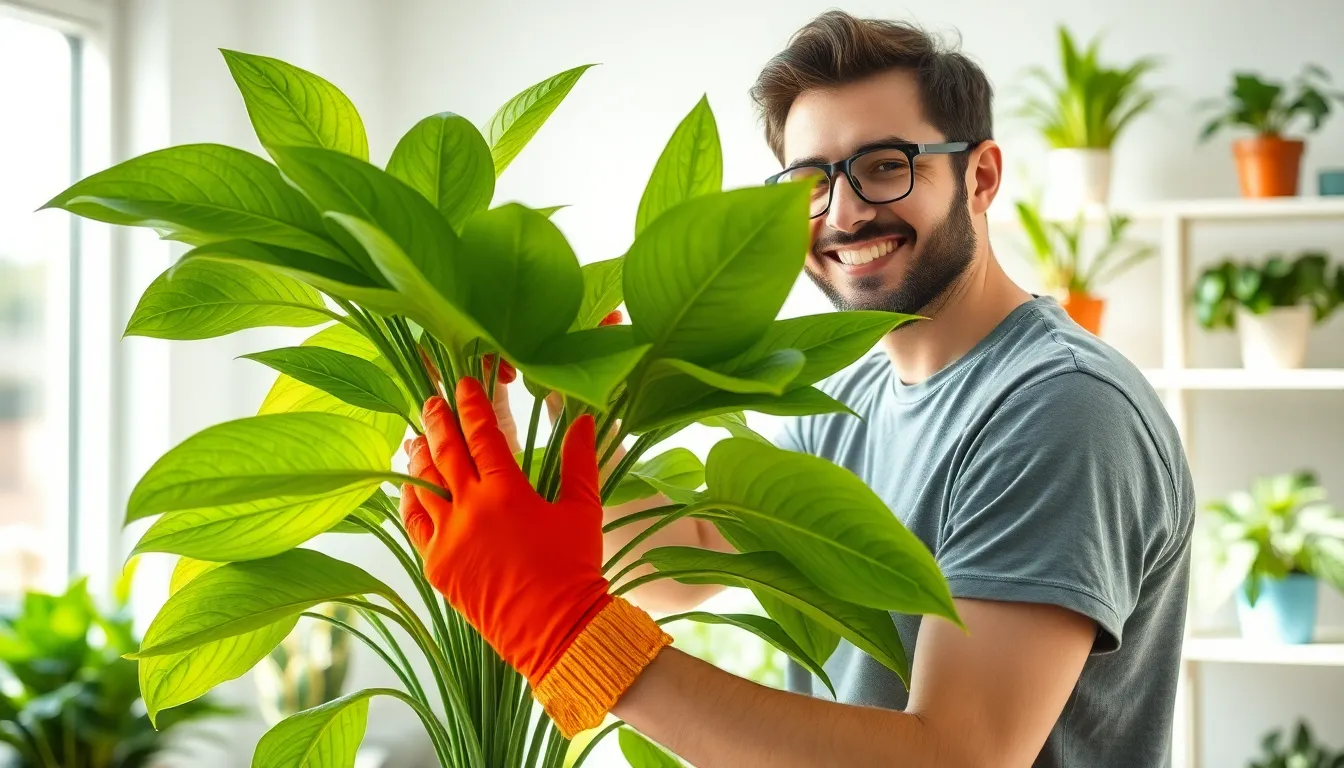
Pruning large indoor plants keeps them healthy and maintains their desired shape as they grow. We’ll guide you through essential techniques that promote vigorous growth while preventing your plants from becoming unruly.
Removing Dead or Yellowing Leaves
First, we identify which leaves need removal to maintain plant health. Yellow leaves should remain on the plant until they fully turn color, allowing the plant to absorb remaining nutrients before natural shedding occurs. Dead or brown leaves require immediate gentle removal to prevent pest attraction and maintain the plant’s appearance.
Timing matters when removing yellowing foliage from our large indoor plants. We avoid premature removal of yellow leaves since plants reabsorb valuable nutrients from these leaves during the natural aging process. Completely yellowed leaves can be gently plucked without causing harm to the plant’s overall health.
Regular leaf removal prevents decay and pest problems in our indoor garden. Dead foliage attracts unwanted insects and creates breeding grounds for harmful bacteria. We inspect our plants weekly to catch yellowing or damaged leaves early before they become problematic.
Encouraging Bushier Growth Patterns
Strategic cutting techniques promote fuller, more attractive plant shapes. We make clean cuts just above leaf nodes or buds to stimulate new shoot development in desired directions. Stepping back periodically helps us assess the plant’s overall form and identify areas needing adjustment.
Growth control prevents our large plants from becoming leggy or unbalanced. Trimming uneven or undesirable growth guides the plant toward a more compact, bushier appearance. We focus on areas where the plant appears sparse or where growth extends beyond our preferred boundaries.
Conservative pruning protects plant health while achieving desired results. Never remove more than 25% of the plant’s foliage during a single pruning session to avoid shocking the system. We plan major shaping activities during spring and summer when plants actively grow and recover more quickly from pruning stress.
Tools and Techniques for Safe Pruning
Proper equipment ensures clean cuts that heal quickly and prevent disease transmission. We use sharp, sterilized scissors or pruning shears for all cutting activities on our large indoor plants. Sterilization between plants prevents spreading potential pathogens throughout our collection.
| Essential Pruning Tools | Purpose |
|---|---|
| Sharp scissors | Clean cuts on smaller stems |
| Pruning shears | Thicker branches and stems |
| Sterilizing solution | Disease prevention |
| Clean cloth | Tool cleaning |
Cutting techniques determine how successfully our plants respond to pruning. We position cuts just above nodes or buds to encourage healthy new growth in the right direction. Thinning dense areas improves air circulation and allows better light penetration throughout the plant canopy.
Seasonal timing maximizes our pruning success with large indoor plants. Major pruning activities work best during spring or summer when plants actively grow and recover faster from cutting stress. Daily maintenance pruning, such as removing individual yellow leaves or small stems, can happen year round without harming plant health.
Troubleshoot Common Problems with Large House Plants Indoor
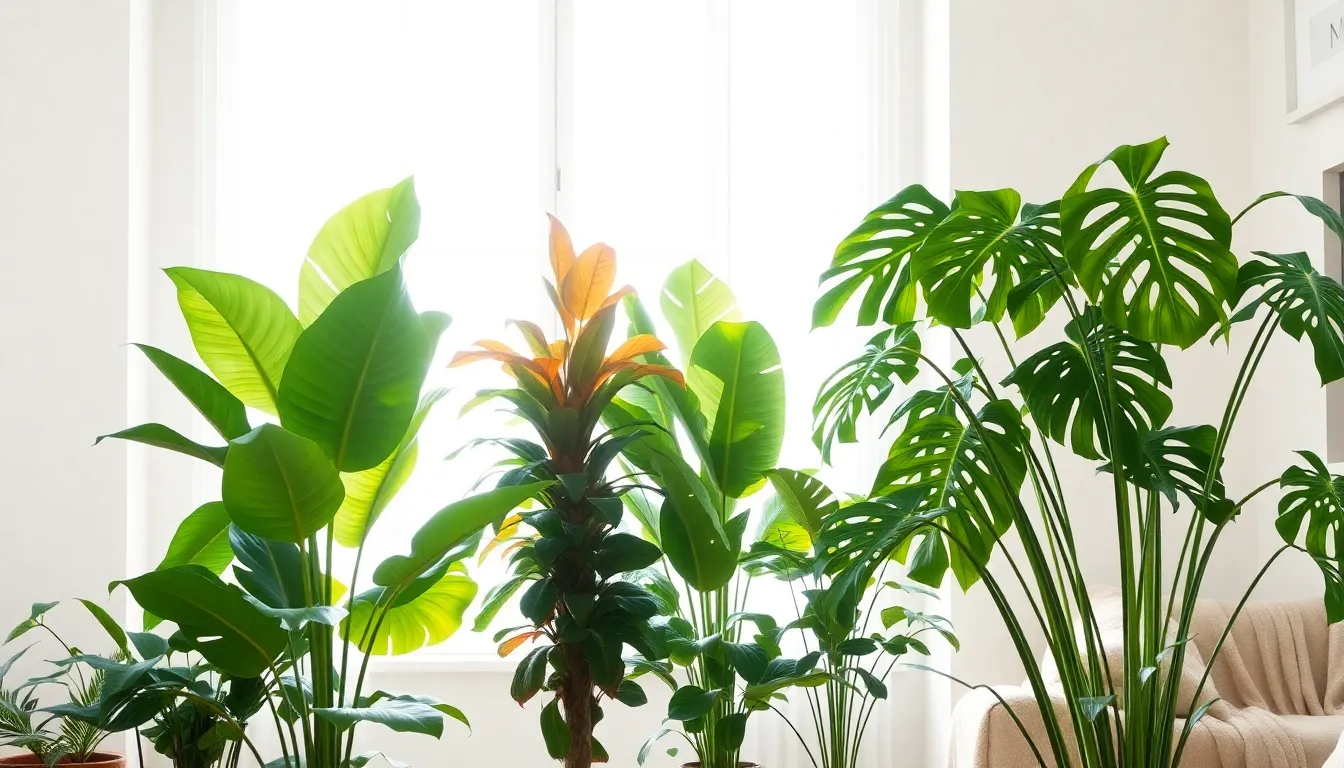
Even the most diligent plant parents encounter challenges when caring for large indoor house plants. We’ll address the most common issues and provide practical answers to keep your statement plants thriving.
Yellowing Leaves and Overwatering
Yellowing leaves signal overwatering in most large indoor plants. These bigger specimens require less frequent watering since their substantial volume of potting soil retains moisture much longer than smaller plants. We recommend checking watering intervals that typically range from once weekly to monthly depending on your plant species.
Checking soil moisture prevents excess watering disasters. Insert your finger 2 inches deep into the soil before watering, or use a moisture meter for more precise readings. Soggy soil creates perfect conditions for root rot, which manifests as yellowing leaves starting from the bottom of the plant.
Removing accumulated water from saucers stops root problems. Standing water in drainage trays suffocates roots and encourages bacterial growth. We suggest emptying saucers within 30 minutes after watering to maintain healthy root systems in your large house plants.
Brown Tips and Low Humidity
Brown tips indicate low humidity issues affecting large tropical house plants. Indoor air often lacks the moisture these plants need, especially during winter months when heating systems dry out our homes. Most large tropical specimens require humidity levels between 40-60% to prevent leaf tip browning.
Increasing humidity creates healthier growing conditions for large plants. Place a humidifier near your plant groupings, or mist leaves regularly with distilled water. Grouping large plants together naturally creates a microenvironment with higher moisture levels through collective transpiration.
Avoiding dry air sources protects plant foliage from damage. Keep large house plants away from heating vents, air conditioners, and direct heat sources that strip moisture from surrounding air. Strategic placement near naturally humid areas like bathrooms or kitchens benefits moisture loving species.
Pest Identification and Treatment
Common pests target large indoor house plants through various symptoms. Spider mites create fine webbing on leaves, scale insects leave sticky honeydew residue, and mealybugs appear as white cotton-like clusters on stems and leaf joints. Early detection through weekly plant inspections prevents small problems from becoming major infestations.
Isolating affected plants stops pest spread to healthy specimens. Move infected large house plants away from your collection immediately upon discovering pests. Clean leaves thoroughly with a damp cloth or mild insecticidal soap solution to remove visible insects and their eggs.
Treating severe infestations requires targeted pest control methods. Apply indoor-safe pesticides according to manufacturer instructions for persistent problems. We recommend systemic treatments for scale insects and horticultural oils for spider mites, always testing products on a small leaf section first to prevent plant damage.
Style Large House Plants Indoor as Living Decor
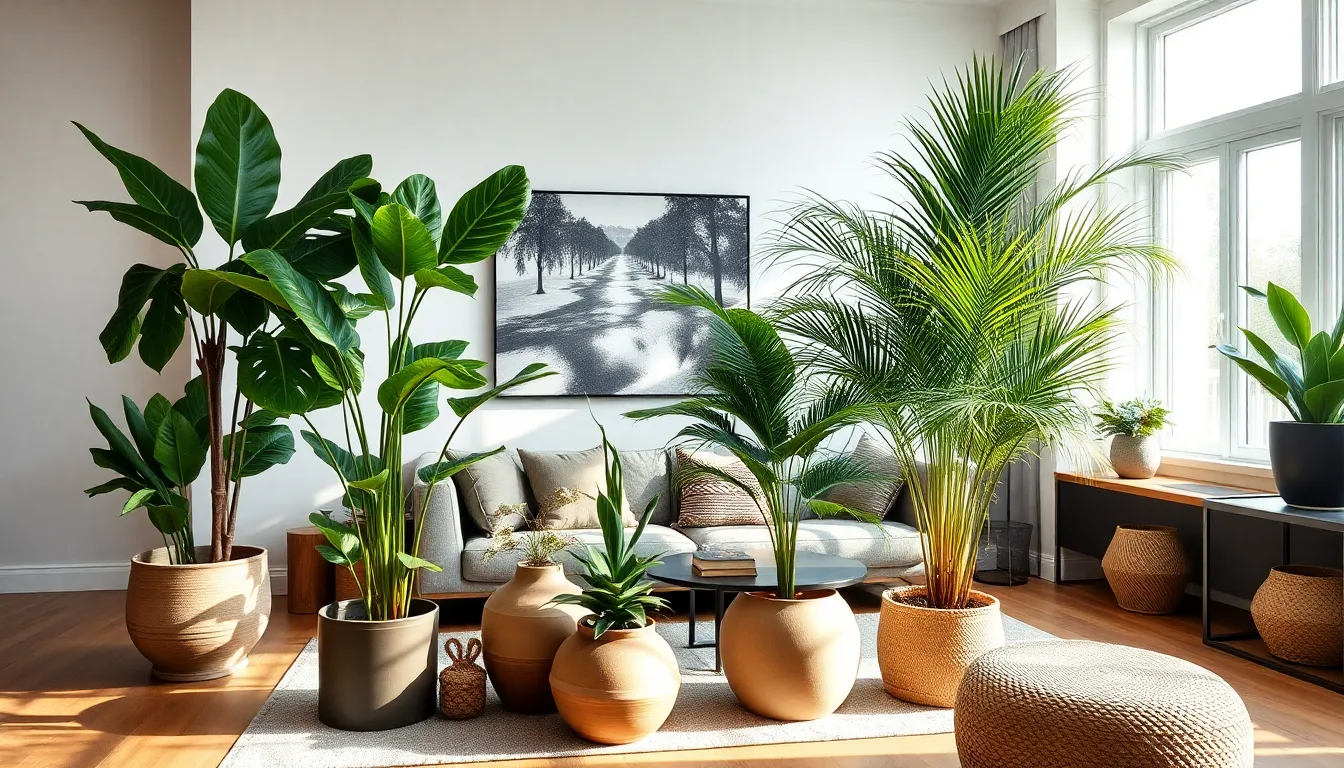
Now that we’ve mastered the basics of plant care, let’s explore how to transform these botanical beauties into stunning living decor elements that elevate our interior spaces.
Creating Plant Groupings and Clusters
Grouping large house plants together enhances their impact and creates vibrant, natural vignettes that serve as living art installations. We recommend mixing plants with varied leaf shapes, colors, and heights to add depth and visual complexity to any room.
Pairing broad-leafed Fiddle Leaf Figs with feathery Areca Palms creates ever-changing visual contrast that draws the eye and adds texture to our spaces. The sculptural quality of spiky Dracaena Marginata complements the softer forms of these statement plants beautifully.
Clusters work best when we include smaller companion plants to soften edges and fill gaps between our larger specimens. This layered approach generates a lush indoor garden feel that transforms corners into tropical retreats.
Strategic placement of plant groupings near windows or in room corners maximizes their visual impact while ensuring each plant receives adequate light. We suggest creating triangular arrangements with our tallest plant in back and shorter companions in front.
Choosing Decorative Planters and Stands
Decorative planters elevate large plants and serve as essential design elements that complement our interior styles. Stylish ceramic pots with matte or glossy finishes provide timeless appeal that works across various decor themes.
Woven baskets bring natural texture and warmth to our plant displays while offering excellent drainage for healthy root systems. These versatile containers work particularly well in bohemian, Scandinavian, or coastal interior styles.
Metal stands and wooden bases raise plants closer to eye level, improving their sculptural quality and allowing better light access. Elevated positioning creates dramatic focal points while protecting our floors from water damage.
Choosing planter colors that harmonize or contrast with our room palette amplifies visual appeal significantly. Neutral tones like white, cream, or terra cotta provide versatile foundations, while bold colors create striking accent pieces.
Practical considerations matter equally when selecting planters, as proper drainage prevents root rot and protects our furniture surfaces. We always ensure our decorative containers include drainage holes or use them as cachepots for functional growing pots.
Incorporating Plants into Interior Design
Large plants integrate seamlessly into interiors by defining spaces, softening architectural lines, and adding essential biophilic benefits to our living environments. Their organic forms create beautiful contrast against hard materials like glass, metal, or concrete.
Corner placement works exceptionally well for plants like Bird of Paradise or Rubber Plants, which can reach impressive heights of 4 to 15 feet and create dramatic vertical interest. These specimens transform unused corners into vibrant focal points.
Positioning plants as room dividers offers creative answers for open floor plans while maintaining natural light flow. Tall specimens like Fiddle Leaf Figs or Umbrella Plants create subtle separation between living areas without blocking sightlines.
Plants work beautifully next to furniture as natural accent pieces that soften hard edges and add life to our seating areas. Monstera Deliciosa with its iconic split leaves fits perfectly beside modern sofas or eclectic armchairs.
Lighting considerations remain crucial when incorporating plants into our design schemes, as many large specimens thrive near windows with filtered light. We position plants where they’ll receive adequate illumination while contributing to our overall aesthetic vision.
Entryway placement creates welcoming first impressions with statement plants that greet guests and establish our home’s natural, vibrant atmosphere from the moment they enter.
Conclusion
We’ve covered everything you need to know about successfully growing and styling large indoor house plants. From selecting the perfect species for your lighting conditions to mastering essential care techniques like watering pruning and repotting these green giants can truly transform your living space.
The key to success lies in understanding each plant’s exact needs and creating the right environment for growth. Whether you choose a dramatic Bird of Paradise for your sunny corner or a low-maintenance rubber plant for dimmer areas you’re well-equipped to make informed decisions.
Remember that large house plants are more than just decorative elements – they’re living investments that’ll reward your care with years of natural beauty air purification and enhanced well-being. Start with one statement plant and watch as your confidence grows along with your indoor jungle.
Frequently Asked Questions
What are the best large house plants for low-light conditions?
The top large house plants for low-light areas include fiddle leaf figs, rubber plants, and monstera deliciosa. Fiddle leaf figs adapt well to lower light and create striking silhouettes. Rubber plants are extremely easy to maintain and thrive in minimal light conditions. Monstera deliciosa flourishes in shadowy environments while developing unique, eye-catching leaf patterns.
Which large indoor plants work best in bright, sunny spaces?
For bright, sunny locations, consider Bird of Paradise, Dracaena, and Yucca plants. Bird of Paradise creates dramatic height with striking flowers when given adequate sunlight. Dracaena offers architectural interest and adapts to various lighting conditions. Yucca plants bring desert aesthetics indoors, thrive in bright light, and require minimal maintenance.
Where should I place large indoor plants for optimal growth?
Position large plants in corners to create focal points while maximizing floor space. Place them near windows for natural light access, ensuring they receive bright, indirect sunlight. Keep plants away from heat sources like radiators and air vents, and avoid drafty areas to protect them from temperature extremes.
How often should I water large house plants?
Water large house plants weekly, though frequency varies from every 1-4 weeks depending on species and environmental conditions. Check the top 2 inches of soil for dryness before watering. Increase watering during growing season (spring to early fall) and reduce frequency during dormant months (fall and winter).
When should I repot my large house plants?
Repot when you notice roots appearing on the soil surface, stunted growth, or soil drying out quickly. Choose a pot 1-2 inches wider than the current container with proper drainage holes. Use well-draining potting mix specifically formulated for large plants to prevent waterlogging while retaining adequate moisture.
How do I properly prune large indoor plants?
Remove dead or yellowing leaves promptly using clean, sharp pruning tools. Perform major pruning during growing season for optimal recovery. Make strategic cuts to encourage bushier growth patterns. Always use proper pruning shears or scissors to prevent damage and ensure clean cuts that heal properly.
What are common problems with large house plants and their solutions?
Yellowing leaves typically indicate overwatering – check soil moisture and adjust watering schedule. Brown leaf tips suggest low humidity – increase moisture around plants. For pest issues, isolate affected plants immediately and treat with appropriate solutions. Monitor plants regularly to catch problems early and prevent spread.
How can I use large house plants as decorative elements?
Create visual impact by grouping plants with varied leaf shapes and colors together. Choose decorative planters and stands that complement your interior style while ensuring proper drainage. Use large plants to define spaces, soften harsh architectural lines, and create welcoming atmospheres throughout your home.

